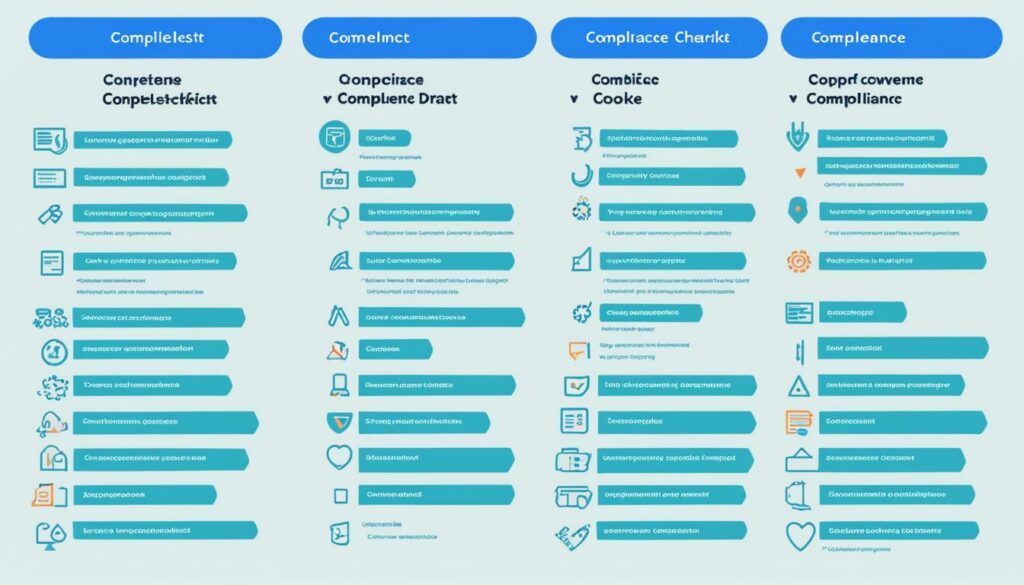Creating, developing, and maintaining a website for your business requires understanding and implementing website compliance. But what exactly does website compliance entail? How do you ensure that your website meets the necessary requirements to avoid legal issues and penalties? In this article, we will explore the world of website compliance, including regulations such as the Americans with Disabilities Act (ADA), the General Data Protection Regulation (GDPR), and the California Consumer Privacy Act (CCPA). Join us as we uncover the key aspects of website compliance and provide you with the knowledge and tools to ensure that your website is legally compliant and user-friendly.
Key Takeaways:
- Website compliance involves adhering to legal regulations and industry standards to ensure accessibility, privacy, and consumer protection.
- The ADA focuses on website accessibility for individuals with disabilities, while the GDPR and CCPA safeguard personal data and privacy rights.
- Website owners should conduct website audits, implement best practices, and seek professional assistance to ensure compliance.
- Understanding the requirements of each regulation is essential to avoid penalties and maintain the trust of visitors.
- By prioritizing website compliance, businesses can create a compliant and user-friendly website that respects the rights and needs of all users.
Understanding Website Compliance
Website compliance is a crucial aspect of creating and maintaining a successful online presence. By adhering to legal requirements and industry standards, you can ensure that your website meets accessibility, privacy, and consumer protection guidelines. Understanding the key regulations such as the Americans with Disabilities Act (ADA), the General Data Protection Regulation (GDPR), and the California Consumer Privacy Act (CCPA) is essential to avoid legal consequences and provide a positive user experience.
ADA Compliance:
Websites must be accessible to individuals with disabilities under the ADA. This includes making sure that content can be easily navigated and understood by users who rely on assistive technologies such as screen readers or voice recognition software. Implementing practices like providing accurate alt-text for images and creating a clear content hierarchy can enhance accessibility.
GDPR Compliance:
The GDPR aims to protect the personal data of individuals in the European Union. If your website collects personal information from EU visitors, it’s important to prioritize data protection. This involves obtaining proper consent for data processing, clearly outlining data collection practices, and offering users the ability to access and delete their personal data upon request.
CCPA Compliance:
The CCPA grants privacy rights to residents of California and applies to businesses collecting personal information from Californians. To achieve compliance, businesses must provide transparent information about data collection and sharing practices, allow users to opt-out of data selling, and respect consumer privacy rights.
By understanding and implementing the requirements of these regulations, you can create a compliant and trustworthy website that prioritizes accessibility, data privacy, and consumer rights.
“Website compliance ensures that your online presence is accessible, privacy-focused, and aligned with consumer protection guidelines. By meeting the requirements of the ADA, GDPR, and CCPA, you can build a website that provides equal access, safeguards personal data, and respects user privacy.”
Americans with Disabilities Act (ADA) Compliance
Ensuring ADA compliance is crucial for websites to be accessible to individuals with disabilities. While there are no specific guidelines outlined by the ADA for web accessibility, adhering to the Web Content Accessibility Guidelines (WCAG) 2.0 AA is widely regarded as a leading standard.
To make your website accessible, consider implementing the following practices:
- Provide alt-text for images: Including descriptive alternative text for images allows screen reader users to understand the visual content. It also improves search engine optimization (SEO) by providing context for search engine crawlers.
- Ensure content can be read by screen readers: Optimizing the code structure, using proper headings, and providing meaningful link text helps screen readers navigate and comprehend your website’s content effectively.
- Follow a clear content hierarchy: Organize your content with headings, subheadings, and paragraphs to enhance readability and make it easier for users to navigate using assistive technologies.
Conducting a website audit is an essential step in identifying any accessibility issues and ensuring ADA compliance. It involves reviewing the website’s design, structure, and content to identify areas of improvement. Seeking the assistance of a professional team experienced in web accessibility can provide valuable insights and technical expertise.
By prioritizing ADA compliance and implementing accessibility best practices, you can create an inclusive online experience for all users, regardless of their abilities.

As an example, here is a table comparing the features and capabilities of popular screen readers:
| Screen Reader | Operating System Compatibility | Additional Features |
|---|---|---|
| JAWS | Windows | Supports a wide range of applications and provides advanced customization options. |
| VoiceOver | iOS and macOS | Integrated with Apple devices, offers multi-language support, and includes advanced navigation gestures. |
| NVDA | Windows | Free and open-source, regularly updated with new features, and compatible with many applications. |
Understanding the capabilities of different screen readers helps website owners optimize their websites for a wider range of users.
General Data Protection Regulation (GDPR) Compliance
When it comes to protecting the personal data of individuals in the European Union, GDPR compliance is essential. If your website collects personal data, such as through contact forms or analytics, it falls under the jurisdiction of the GDPR. To ensure compliance and maintain the trust of your website visitors, there are key steps you should take:
-
Inform users about your data collection practices:
Clearly disclose how you collect, store, and process personal data on your website. This information helps users understand how their data is being used and enables them to make informed decisions.
-
Obtain consent for data processing:
Prioritize obtaining explicit consent from users before processing their personal data. This can be achieved through checkboxes or other consent mechanisms that are easy to understand and use.
-
Enable user access and deletion of personal data:
Offer users the ability to access the personal data you have collected about them and give them the option to delete or modify their information. This ensures transparency and allows users to exercise their rights under the GDPR.
By adhering to GDPR compliance requirements, you can protect the personal data of your website visitors and avoid potential fines and legal consequences. Building trust and maintaining a transparent relationship with your audience is crucial in the digital age.
Remember, consent, transparency, and data protection are the pillars of GDPR compliance.
Pro Tip: Use Cookie Consent Banners
“Cookie consent banners play a vital role in GDPR compliance. They inform visitors about the use of cookies and request their consent. Make sure your cookie consent banner is prominently placed on your website and contains clear information about the types of cookies used and their purpose.”

California Consumer Privacy Act (CCPA) Compliance
If your website collects personal data from California residents, it’s important to understand and comply with the California Consumer Privacy Act (CCPA). The CCPA grants privacy rights to California residents and imposes obligations on businesses that handle personal information. To maintain CCPA compliance, you need to prioritize consumer privacy rights and ensure transparent data practices.
Here are key steps to ensure CCPA compliance:
- Inform consumers: Clearly communicate how you collect, use, and disclose personal data. Provide a privacy notice that outlines the categories of personal data collected and the purposes for which it is used.
- Offer opt-out options: Give users the ability to opt out of the sale of their personal information. Include a “Do Not Sell My Personal Information” link on your website.
- Secure personal data: Implement appropriate security measures to protect personal information from breaches or unauthorized access.
- Honor consumer rights: Respect consumer requests to access, delete, or modify their personal data. Establish procedures to handle these requests efficiently.
Here’s an example of a compliance checklist:
| CCPA Compliance Checklist |
|---|
| Inform consumers about data collection and use practices |
| Provide opt-out options for data selling |
| Maintain secure storage and handling of personal data |
| Respect consumer rights for access and deletion of personal data |
By adhering to CCPA compliance requirements, you can protect consumer privacy rights, build trust with your users, and avoid penalties. Implementing proper data management practices can contribute to the overall success and reputation of your website and business.
Conclusion
Navigating the complexities of website compliance can be challenging, but it is crucial for businesses to ensure they meet legal requirements and industry standards. ADA compliance ensures your website is accessible to individuals with disabilities, allowing them to fully engage with your content and services. By implementing practices such as providing alt-text for images and ensuring compatibility with screen readers, you can create a more inclusive online environment for all users.
GDPR compliance plays a vital role in safeguarding the personal data of individuals in the European Union. By obtaining explicit consent for data processing, providing transparent data collection practices, and respecting user rights, you can build trust and maintain the privacy of your website visitors. It is essential to stay updated with GDPR regulations to avoid penalties and protect the sensitive information of your users.
For businesses collecting personal data from California residents, CCPA compliance is a must. This regulation grants privacy rights to residents and requires transparency in data collection and sharing practices. By offering opt-out options for data selling and respecting consumer privacy rights, you can demonstrate your commitment to protecting user information and maintaining compliance.
Understanding and implementing website compliance best practices, such as ADA compliance, GDPR compliance, and CCPA compliance, helps you create a compliant and user-friendly website that respects accessibility, privacy, and consumer rights. If you need assistance with website compliance, reach out to professionals who specialize in this area. They can provide guidance, conduct audits, and ensure your website meets the necessary requirements, giving you peace of mind and allowing you to focus on growing your online presence.
FAQ
Q: What is website compliance?
A: Website compliance refers to following regulations and standards such as ADA, GDPR, and CCPA to ensure your website meets accessibility, privacy, and consumer protection guidelines.
Q: What is ADA compliance?
A: ADA compliance requires making your website accessible to individuals with disabilities by implementing practices such as providing alt-text for images and ensuring content can be read by screen readers.
Q: What is GDPR compliance?
A: GDPR compliance involves protecting the personal data of individuals in the European Union by providing clear information about data collection practices, obtaining consent from users, and allowing users to access and delete their personal data.
Q: What is CCPA compliance?
A: CCPA compliance grants privacy rights to California residents and requires businesses to provide clear information about data collection and sharing, offer opt-out options for data selling, and respect consumer privacy rights.
Q: Why is website compliance important?
A: Website compliance is important to avoid legal issues and penalties, maintain the trust of your website visitors, and ensure your website is accessible, respects privacy, and protects consumer rights.
Q: How can I ensure website compliance?
A: To ensure website compliance, you can conduct a website audit, implement best practices such as following WCAG 2.0 AA guidelines, providing clear data collection information, obtaining consent, and seeking professional assistance if needed.












